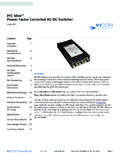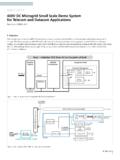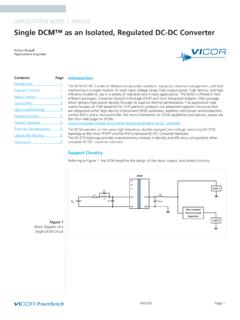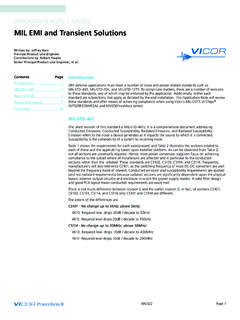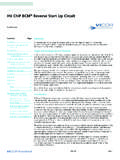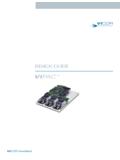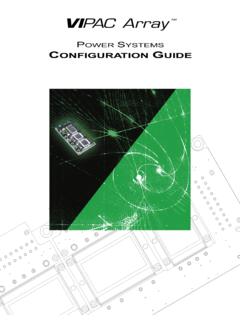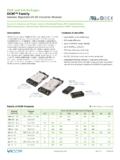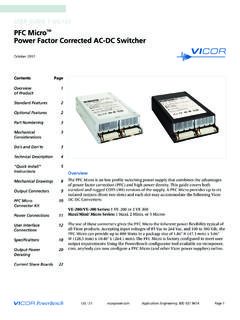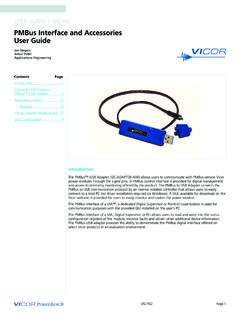Transcription of Soldering Methods and Procedures for Vicor Power Modules
1 AN:208 Page 1 Soldering Methods and Proceduresfor Vicor Power ModulesLead-Free Pins (RoHS); TIN / LEAD PINS (see page 7)OverviewThe following pages contain Soldering information for the following Vicor product families; Maxi, Mini, Micro; VE-200, VE-J00; VI Brick , and similar package filters and front-ends. This document is intended to provide guidance for making high-quality solder connections of RoHS-compliant Vicor Power Modules to printed circuit boards. This application note applies to lead-free Soldering of Vicor s RoHS-compliant Modules . The following provides an outline for appropriate Soldering Procedures and the evaluation of solder joints to ensure an optimal connection to the Power module.
2 Common Soldering defects will be examined and direction will be provided for detecting and handling them. Vicor s manufacturing facilities use the IPC-A-610 standards for establishing quality solder joints. It is recommended that manufacturing processes using Vicor Modules refer to these same standards, which can be found, along with supporting documentation, at of a Good Solder JointThe IPC-A-610 standard requires that solder fill at least 75% of the barrel to ensure a solid connection. Ideally, all connections should have a 100% fill. To accomplish this, the solder applied to both the barrel and the pin must exhibit a process known as wetting.
3 Wetting occurs when liquid solder on a surface is heated to the point that it loses a significant amount of latent surface tension and evenly coats the surface via capillary action (both cohesion and adhesion).During the Soldering process wetting can be identified by an even coating of solder on the barrel and pin. In addition, coating the surface of barrel and pin, the solder will gather at the intersection of the two and produce a trailing fillet along each surface. Once wetting has occurred, then upon solidification it will bond appropriately to both components, producing a quality 1 shows a side profile of a good solder joint with a Power module.
4 Notice that the solder forms a concave meniscus between pin and barrel. This is an example of a properly formed fillet and is evidence of good wetting during the Soldering process. The joint between solder and pin as well as solder and pad should always exhibit a feathered edge. In Figure 1 it can also be seen that the solder covers a good deal of the surface area of both the pin and the pad. This is also evidence of good wetting. (Notice also that the solder joint is dull compared to leaded processing). This is evidence of good immobilization of the joint during cooling as well as good cleaning of the board prior to Soldering .
5 All Soldering connections should exhibit similar characteristics regardless of whether they are soldered by hand, by fountain, or by examining a solder joint, be sure that there is no solder connecting one pad to another. This is known as a solder bridge and will be discussed 1 Side profile of Maxi or Mini module s RoHS solder jointAPPLICATION NOTE | AN:208 ContentsPageOverview1 Analysis of a Good Solder Joint 1 Soldering Procedures 2 References6VI BRICK Standoff Kits 6 Tin / Lead Pins 7 References12 AN:208 Page 2 Soldering ProceduresHand SolderingBefore Soldering , make sure that the PCB is clean and free of debris, chemical residue, or liquid.
6 It is not recommended that additional flux other than what is contained in the solder be used during Soldering because it potentially leaves a residue that cannot be removed without potentially damaging or compromising the Power module. Also, the presence of these residues on the Modules may cause harm or improper pins on Vicor Modules are optimized to provide a low-resistance electrical connection. The final mounting scheme for any module should be designed to minimize any potential mechanical stress on the pins and solder joints. Modules with heat sinks or Modules used in systems that are subject to shock or vibration should use standoffs to minimize stress on the pins.
7 It is not recommended that discrete wires or connectors be soldered directly onto a necessary for a good solder connection is pin protrusion from the PCB. It is not possible to create a good solder joint without some protrusion of module pins from the PCB. If the PCB is too thick to allow good pin protrusion, consider using Vicor module accessories such as sockets to allow proper mounting. Before Soldering , the module should be mechanically affixed or immobilized with respect to the PCB to ensure no movement during the Soldering process. The standoffs can be used for this process. Vicor Power Modules contain two types of pins: Power pins (which deliver the Power to the load and are typically sized according to the rated output current) and signal pins (which typically carry very little current and are of a uniform size across a given product family).
8 The larger the pin, the more Soldering time required to form an adequate connection. In addition to the sizing of the pin, the time required to create a robust connection will vary depending on several parameters: 1. PCB Thickness. The thicker the printed circuit board, the more heat it is able to dissipate, and will require more Soldering Copper Trace Area. Power pins require large copper traces to minimize resistive Power losses in carrying the Power to the load. Since the copper tends to conduct heat well, the actual sizes of these copper traces directly affect the amount of time necessary to heat the PCB Copper Trace Thickness.
9 As above, the thickness of the copper trace is a function of output current of the module, and has a direct impact on the amount of Soldering time. Typically, PCB copper thickness is specified in terms of weight per square foot, typically 2oz. or 3oz. copper for current-carrying planes. 4. Soldering Iron Power . A higher Power Soldering iron can source more heat and thus take less time to heat a PCB trace. As a Soldering iron is heating a point on the board, everything that is adjacent to this point is being heated as well, including the Vicor Power module. A large copper trace, because it conducts heat very well, will exhibit less of a thermal gradient, and thus a low- Power Soldering iron will have to heat the whole trace to a higher temperature before the area close to the iron is hot enough to flow solder.
10 Because the trace and board are both dissipating and conducting thermal energy, some irons may not have enough Power to heat a trace to the temperature that will allow proper Tip Temperature. Typical SAC-type solder melts at 419 491 F (215 225 C). Pb-free Soldering requires a tip temperature of about 800 F. A higher tip temperature will bring the barrel and pin above the melting point of solder faster. However, a higher tip temperature may cause damage to the pad, printed circuit board, or module Type of Lead-free Solder. The actual melting point of the solder varies depending on the type of solder used and affects the necessary temperature of the pad and pin for flow.
